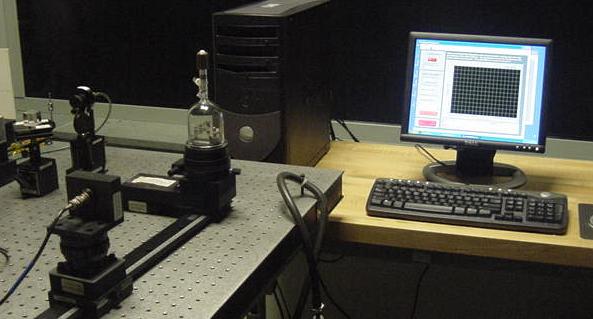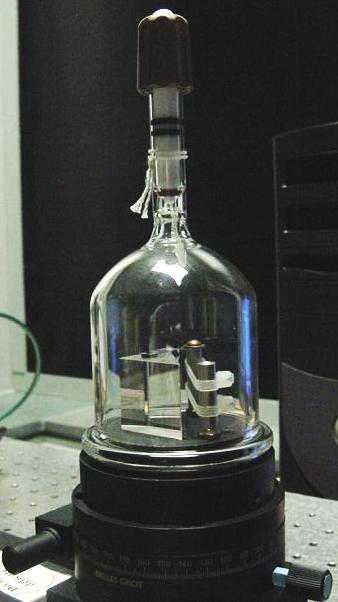Surface plasmon resonance



In this experiment monochromatic light is shined on a thin metal film so as to create many-body excitations, known as surface plasmons, in the electron gas of the film. Students learn that as photons excite the surface plasmons, energy and momentum are conserved, leading to the concept that many-body excitations behave in many ways like single particles. Students map out the surface plasmon resonance curve and then use a computer program to model the resonance curve and determine the best values for the film thickness and the (complex) dielectric constant.
Discussion Questions
- Imagine you could do this experiment with a blue laser (wavelength = 473 nm). Sketch a picture of what you would expect the reflectivity curve (normalized intensity versus incident angle) to look like, and sketch on the same picture the curve you get for the red laser. Then explain, in detail, how you came up with the expected reflectivity curve for a the blue light, in particular, relating it to the plasmon dispersion relation.
- In the SPR Modeling Analysis program the three principal parameters are the film thickness, the imaginary part of the
film dielectric constant, and the real part of the film dielectric constant.
- How does adjusting each one of these
parameters, separately, affect the modeled curve? Why, physically, does each parameter cause the change that you see? (You
may want to play with the modeling program for a while before attempting to answer this question.)
- Vary one of the parameters (e.g. the film thickness) by 20%. Can you obtain an acceptable fit by adjusting all the other parameters to re-optimize the fit?
- How does adjusting each one of these
parameters, separately, affect the modeled curve? Why, physically, does each parameter cause the change that you see? (You
may want to play with the modeling program for a while before attempting to answer this question.)
Experiment and background information
- Write-up
- Lecture slides on Optical Properties of solids (Olmstead) Gives basic theory behind dielectric constants and conductivity.
- Lecture notes on surface plasmons (Pengra)
- Simon, H. J., D. E. Mitchell, and J. G. Watson, "Surface plasmons in silver films--a novel undergraduate experiment", Am. J. Phys., 43(7), 630-636 (1975).
- Johnson, P. B., and R. W. Christy, "Optical constants of the noble metals", Phys. Rev. B, 6, 4370-4379 (1972).
- Katherine A. Willets and Richard P. Van Duyne, "Localized Surface Plasmon Resonance Spectroscopy and Sensing", Annu. Rev. Phys. Chem., 58:267-297 (2007)
- "Surface Plasmon Resonance", Biacore Technology Note BR-9001-15, September (2001). Biacore is a company that uses SPR to sense the effects of biological molecules on a surface. This note gives a simple explanation of SPR and some nice pictures.